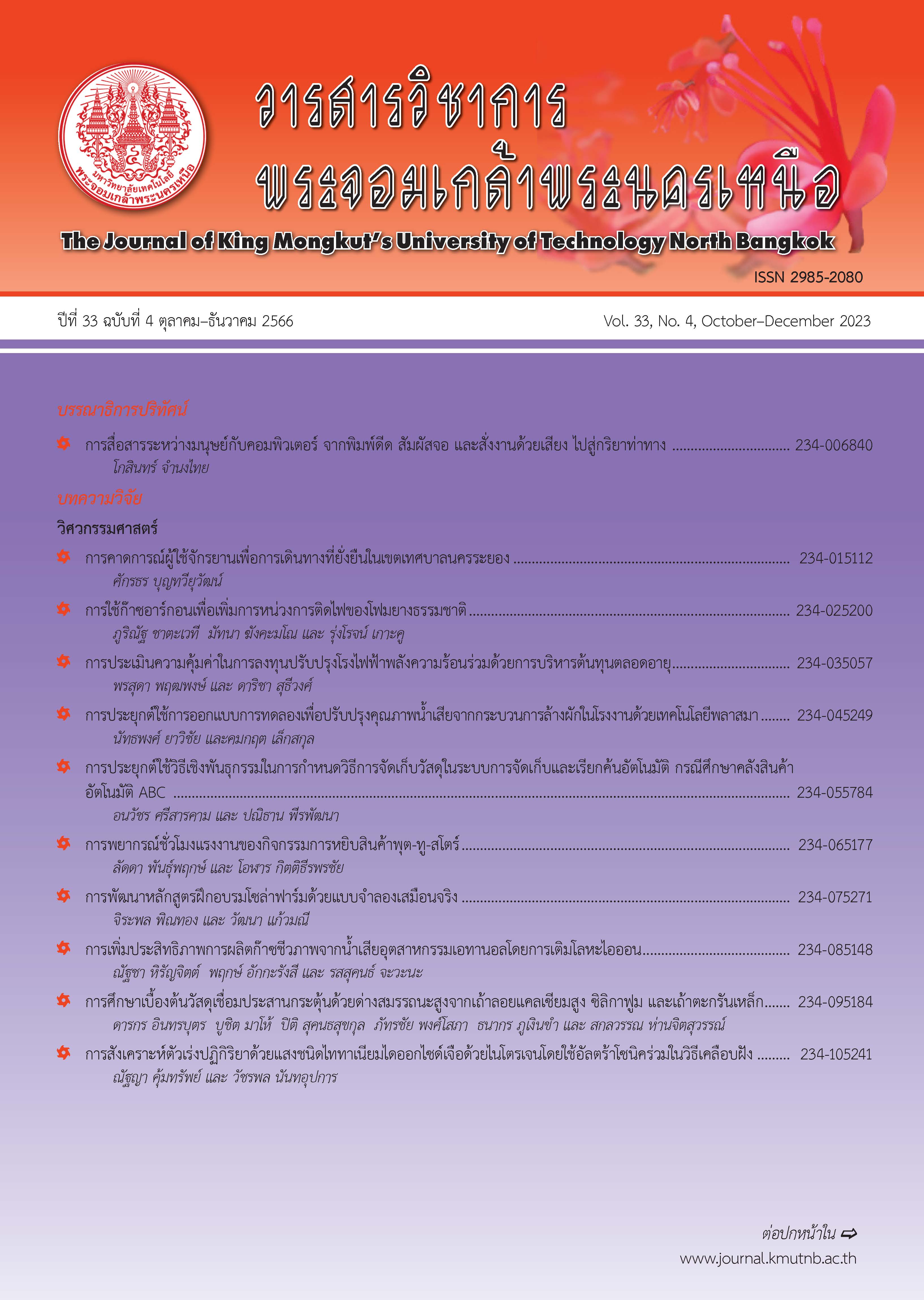การศึกษาเบื้องต้นวัสดุเชื่อมประสานกระตุ้นด้วยด่างสมรรถนะสูงจากเถ้าลอยแคลเซียมสูง ซิลิกาฟูม และเถ้าตะกรันเหล็ก
Main Article Content
บทคัดย่อ
บทความนี้นำเสนอผลกระทบของการแทนที่ซิลิกาฟูมและเถ้าตะกรันเหล็กในวัสดุเชื่อมประสานกระตุ้นด้วยด่างจากเถ้าลอยแคลเซียมสูงต่อคุณสมบัติทางกายภาพและคุณสมบัติเชิงกล โดยการแทนที่เถ้าลอยด้วยซิลิกาฟูมร้อยละ 0–10 โดยน้ำหนักของเถ้าลอย และการแทนที่เถ้าลอยด้วยเถ้าตะกรันเหล็กร้อยละ 0–50 โดยน้ำหนักของเถ้าลอย ในการศึกษานี้จะแปรผันอัตราส่วนของเหลวต่อวัสดุประสานเท่ากับ 0.35, 0.40 และ 0.45 และความเข้มข้นของสารละลายโซเดียมไฮดรอกไซด์เท่ากับ 8 และ 12 โมลาร์ ขณะที่ทุกส่วนผสมจะใช้อัตราส่วนทรายต่อวัสดุประสานเท่ากับ 1.25 และอัตราส่วนสารละลายโซเดียมซิลิเกตต่อสารละลายโซเดียมไฮดรอกไซด์เท่ากับ 1.0 โดยดำเนินการทดสอบความสามารถในการทำงานได้ (ค่าการยุบตัวสัมพัทธ์ และระยะเวลาในการทำงาน) และการทดสอบกำลังรับแรงอัดของวัสดุเชื่อมประสานกระตุ้นด้วยด่าง ผลการทดสอบพบว่า ค่าการยุบตัวสัมพัทธ์มีค่าลดลง ขณะที่ระยะเวลาในการทำงานมีค่าเพิ่มขึ้น ตามปริมาณการแทนที่ซิลิกาฟูมที่เพิ่มขึ้นกำลังรับแรงอัดมีค่าเพิ่มขึ้นเมื่อแทนที่ซิลิกาฟูมถึงร้อยละ 2.5 หลังจากนั้นมีแนวโน้มลดลงตามปริมาณการแทนทีซิลิกาฟูมที่เพิ่มขึ้น ในส่วนของการแทนที่เถ้าตะกรันเหล็กส่งผลให้ค่าการยุบตัวสัมพัทธ์และระยะเวลาการก่อตัวลดลงตามปริมาณการแทนที่เถ้าตะกรันเหล็กที่เพิ่มขึ้น ขณะที่ค่ากำลังรับแรงอัดมีแนวโน้มเพิ่มขึ้นตามปริมาณการแทนที่เถ้าตะกรันเหล็กที่เพิ่มขึ้น
Article Details

อนุญาตภายใต้เงื่อนไข Creative Commons Attribution-NonCommercial-NoDerivatives 4.0 International License.
บทความที่ลงตีพิมพ์เป็นข้อคิดเห็นของผู้เขียนเท่านั้น
ผู้เขียนจะต้องเป็นผู้รับผิดชอบต่อผลทางกฎหมายใดๆ ที่อาจเกิดขึ้นจากบทความนั้น
เอกสารอ้างอิง
B. Metz, O.R. Davidson, P. R. Bosch, R. Dave, and L. A. Meyer, “Contribution of working group III to the Fourth assessment report of the intergovernmental panel on climate change,” Climate change 2007, Cambridge University Press, Cambridge, United Kingdom and New York, NY, USA, 2007, pp. 447–496.
S. Detphan, T. Phoo-ngernkham, V. Sata, C. Detphan, and P. Chindaprasirt, “Portland cement containing fly ash, expanded perlite, and plasticizer for masonry and plastering mortars,” International Journal of GEOMATE, vol 15, no. 48, pp 107–113, 2018.
J. Davidovits, “Chemistry of geopolymeric systems, terminology,” in Proceedings of Geopolymer Second International Conference, Saint-Quentin, 1999, pp. 9–39.
L.K. Turner and F.G. Collins, “Carbon dioxide equivalent (CO2-e) emissions: A comparison between geopolymer and OPC cement concrete,” Construction and Building Materials, vol. 43, pp. 125–130, 2013.
F. Pacheco-Torgal, J. Castro-Gomes, and S. Jalali, “Alkali-activated binders: A review: Part 1. Historical background, terminology, reaction mechanisms and hydration products,” Construction and Building Material, vol. 22, no. 7, pp. 1305–1314, 2008.
T. Bakharev, “Resistance of geopolymer materials to acid attack,” Cement and Concrete Research, vol. 35, no. 4, pp. 658–670, 2005.
T. Bakharev, “Geopolymeric materials prepared using Class F fly ash and elevated temperature curing,” Cement and Concrete Research, vol. 35, no. 6, pp. 1224–1232, 2005.
A. Palomo, M. T. Blanco-Varela, M. L. Granizo, F. Puertas, T. Vazquez, and M. W. Grutzeck, “Chemical stability of cementitious materials based on metakaolin,” Cement and Concrete Research, vol. 29, no. 7, pp. 997–1004, 1999.
S. Sasui, G. Kim, J. Nam, T. Koyama, and S. Chansomsak, “Strength and microstructure of class-C fly ash and GGBS blend geopolymer activated in NaOH & NaOH + Na2SiO3,” Materials, vol. 13, no. 1, 2020.
A. L. I. Allahverdi, E. N. Kani, and M. Yazdanipour, “Effects of blast-furnace slag on natural pozzolanbased geopolymer cement,” Directory of Open Access Journals, vol. 55, no. 1, pp. 68–78, 2011.
P. Chindaprasirt, P. Paisitsrisawat, and U. Rattanasak, “Strength and resistance to sulfate and sulfuric acid of ground fluidized bed combustion fly ash-silica fume alkali-Activated composite,” Advanced Powder Technology, vol. 25, no. 3, pp. 1087–1093, 2014.
P. Chindaprasirt, T. Phoo-ngernkham, S. Hanjitsuwand, S. Horpibulsuke, A. Poowancumf, and B. Injorhor, “Effect of calcium-rich compounds on setting time and strength development of alkali-activated fly ash cured at ambient temperature,” Case Studies in Construction Materials, vol. 9, 2018.
X. Gao, Q. L. Yu, R. Yu, and H. J. H. Brouwers, “Evaluation of hybrid steel fiber reinforcement in high performance geopolymer composites,” Materials and Structures, vol. 50, no. 2, 2017.
Standard Specification for Coal Fly Ash and Raw or Calcined Natural Po26olan for Use in Concrete, ASTM C618-15, 2015.
P. Chindaprasirt, P. De Silva, K. Sagoe-Crentsil, and S. Hanjitsuwan, “Effect of SiO2 and Al2O3 on the setting and hardening of high calcium fly ash-based geopolymer systems,” Journal of Materials Science, vol. 47, no. 12, pp. 4876– 4883, 2012.
Standard Test Method for Flow of Hydraulic Cement Mortar, ASTM C1437-20, 2020.
Standard Test Method for Compressive Strength of Hydraulic Cement Mortars (Using 2-in. or [50-mm] Cube Specimens), ASTM C109/ C109M-13, 2013.
Standard Test Methods for Time of Setting of Hydraulic Cement by Vicat Needle, ASTM C191-19, 2019.
C. Detphan, S. Detphan, K. Chompoovong, T. Phoongernkham, S. Hanjitsuwan, and P. Chindaprasirt, “Mechanical properties of high-calcium fly ash geopolymer with nano- SiO2 particle sizes,” The Journal of KMUTNB, vol. 31, no. 1, pp. 36–46, 2021 (in Thai).
P. Nath and P. K. Sarker, “Effect of GGBFS on setting, workability and early strength properties of fly ash geopolymer concrete cured in ambient condition,” Construction and Building Materials, vol. 66, pp. 163–171, 2014.
T. Phoo-ngernkham, P. Chindaprasirt, V. Sata, S. Pangdaeng, and T. Sinsiri, “Properteis of high calcium fly ash geopolymer pastes containing Portland cement as additive,” International Journal of Minerals, metallurgy and Materials, vol. 20, no. 2, pp. 214–220, 2013.
T. Phoo-Ngernkham, Hanjitsuwan, N. Damrongwiriyanupap, and P. Chindaprasirt, “Effect of sodium hydroxide and sodium silicate solutions on strengths of alkali activated high calcium fly ash containing Portland cement,” KSCE Journal of Civil Engineering, vol. 21, no. 6, pp. 2202–2210, 2017.
T. Sinsiri, T. Phoo-ngernkham, V. Sata, and P. Chindaprasirt, “The effects of replacement fly ash with diatomite in geopolymer mortar,” Computers and Concrete, vol. 9, no. 6, pp. 427–437, 2012.
S. Hanjitsuwan, S. Hunpratub, P. Thongbai, S. Maensiri, V. Sata, and P. Chindaprasirt, “Effects of NaOH concentrations on physical and electrical properties of high calcium fly ash geopolymer paste,” Cement and Concrete Composites, vol. 45, pp. 9–14, 2014.
C. Li, H. Sun, and L. Li, “A review: The comparison between alkali-activated slag (Si + Ca) and metakaolin (Si + Al) cements,” Cement and Concrete Research, vol. 40, no. 9, pp. 1341– 1349, 2010.
J. W. Phair, J. S. J. V. Deventer, and J. D. Smith, “Mechanism of polysialation in the incorporation of zirconia into fly ash-based geopolymers,” Industrial & Engineering Chemistry Research, vol. 39, no. 8, pp. 2925–2934, 2000.

